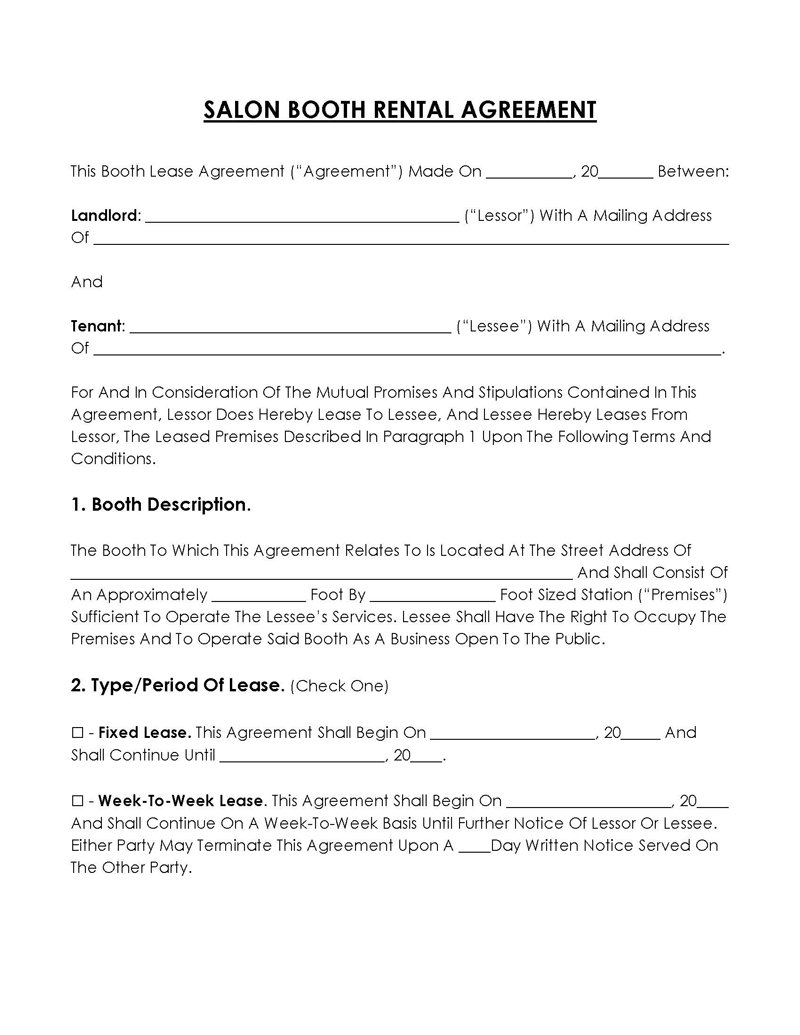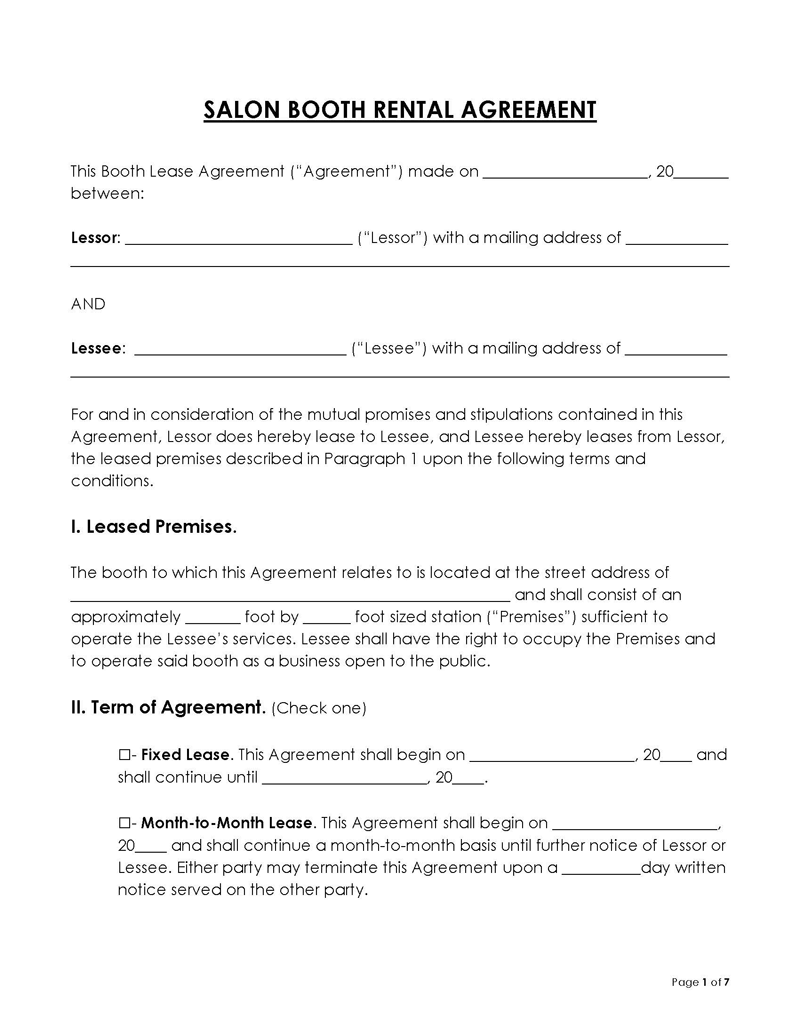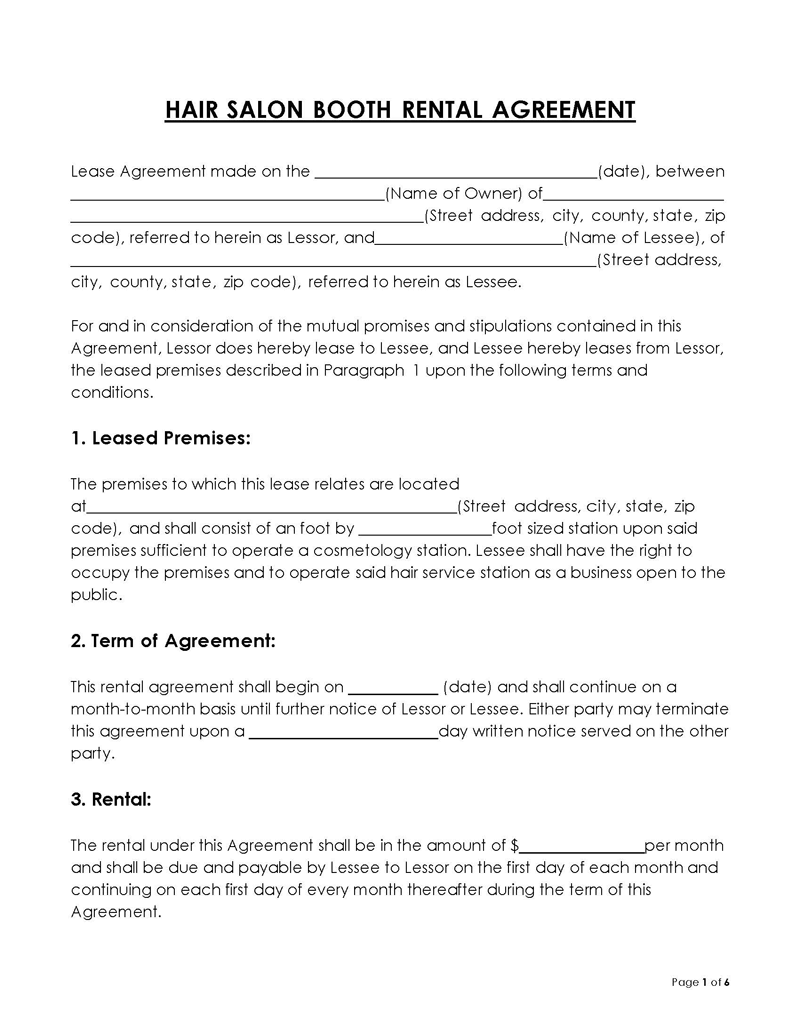Hair styling and care is an industry that has had tremendous growth over the years, with more and more people opting for expensive haircuts and specialized treatment. This industry has more than 882 300 big and small businesses alone.
In 2021, it was recorded that the hair salon industry topped $39.5 billion. A business owner in this industry typically has two options – hire employees to work under them or rent out the booths to hair specialists. You must be familiar with a hair salon booth rental agreement if the latter is your approach.
In this agreement, the hair specialist agrees that they will be providing hair services in a booth inside your salon in exchange for consideration (rental amount). In addition, the agreement outlines the terms agreed upon with the lessee.
This article discusses the ins and outs of renting hair salon booths with a hair salon booth rental agreement.
Download Free Templates
Below are the hair salon agreement templates:
Hair Salon Booth Rental Agreement
A hair salon booth rental agreement is defined as a contract outlining the terms and conditions of renting a booth in a hair salon to an independent hair specialist.
The lessor (the one offering the booth for rent) agrees to allow the lessee (the one renting) to use the booth for hair services in exchange for a specified period and rental amount. Examples of hair services offered in these booths include hair cutting, styling, coloring, cosmetics, massage, etc. The agreement can be for a fixed period, month-to-month or week-to-week. The hair salon owner creates the document. Once signed, the agreement becomes legally binding.
Before the rental agreement is crafted, a meeting should be held with the lessee to discuss the terms of the contract. The terms to be discussed include rent rate, agreement length, termination terms, expectations, and responsibilities of both parties. Ideally, as the hair salon owner, you are expected to provide a station/space, salon equipment, utilities (water and electricity), reception services, products, and other basics.
In addition, you can expect the lessee to pay rent, tax liability, liability insurance, produce a business license, and protect the property. Duties that can be conveyed to the lessee include keeping the salon clean and repairing and maintaining salon equipment. Other terms that ought to be negotiated include expected hours of operation, non-compete clauses, how fees and costs will be shared, etc. The IRS requires the document to certify that the lessee is an independent contractor, not an employee.
How to Use a Booth Rental Agreement?
A booth rental agreement is not limited to hair salons. This agreement can be used in tattoo parlours, nail salons, and other personal service providers. This is because people in these professions often find it challenging to raise the capital to establish their shop, thus creating this opportunity for shop owners. The booth agreement should be personalized to suit the specific terms agreed on with the lessee.
Both parties will utilize the hair salon booth rental agreement as follows:
Lessor (hair salon owner)
As a lessor, the booth rental agreement ensures the applicable rules and regulations are unambiguously communicated to the renter. This includes how much rental payment is expected, the rental period, equipment to be provided, and other conditions of the agreement. This ensures that the lessee cannot claim more space, time, or equipment than stated in the agreement.
In addition, without a booth rental agreement or improper execution, the lessee may have a legal basis to claim more of those aspects of the rental arrangement in court.
Lessee (hair stylist)
A hair salon booth rental agreement is helpful to a lessee as it protects them from unlawful rent increments from the lessor. With a fixed rental rate declared in the agreement, the lessee cannot increase rent without approval or a discussion with the lessee. Without the agreement, lessors can increase rental rates as they deem necessary.
In addition, a booth rental agreement ensures that the lessor contractually guarantees to provide equipment, utilities, and resources needed to run the business.
How Does it Work?
The agreement is created with the lessee to ensure a fair understanding of the arrangement between the two parties. This ensures the business relationship is fruitful and profitable to both parties.
To appropriately execute a hair salon booth rental agreement, follow the steps below:
Look for a qualified hairstylist
The first step is selecting a suitably qualified hair stylist. Look for an experienced and knowledgeable lessee, as they are more likely to have clientele and margins that meet the costs of renting the booth. Next, post a listing on any popular job platform to find a suitable lessee. Makes sure to include prioritized qualifications in the job posting.
Interview the stylist
After reviewing the job seeker profiles or portfolios online, select a few and schedule an interview. Ask for a resume and provide a job application to be completed. The job application is meant to collect personal identification details and consent to conduct a background check. During the interview, find out if the hair stylist would like to work under a hair salon booth rental agreement. Then discuss the benefits of such an agreement.
For example:
Booth renting tends to generate more income for the hair stylist as they pay a fee or percentage of gross revenue to the shop owner. In contrast, both parties receive 50/50 of the revenue sales working as employees.
Other topics to discuss include past business experience, skills, and licenses.
Search background information
After the interview, conduct a background check on the hairstylist. If consent was not given in the job application, have the prospect complete a background check authorization form. Then perform a background check to determine the lessee’s character background. Utilize any online background check providers who perform this service at a fee.
A background check will examine the individual’s court records history, criminal history, sex offender search, and additional details such as DMV records, professional licenses, and education verification.
Verification of the hair stylist
The hair stylist should be licensed to offer services within the respective state. Therefore, verifying the hair stylist’s licensing status in the state’s database of professional hair stylists is vital.
Negotiate the terms
Once a suitable stylist has been identified and approved, negotiate the hair salon booth rental agreement with them. First, discuss all the pertinent details of the arrangement, starting with rent and length of the agreement and following up with other arrangements.
Once you have agreed on terms, create a written contract to solidify how both parties will conduct business. A good hair salon booth rental agreement will include stipulations that satisfy all parties’ needs and interests while remaining within legal bounds.
The hairstylist takes occupancy
After the hair salon booth rental agreement has been signed, the lessee should pay the applicable security deposit and the first month’s rent. They should then be given access to the booth, and they can begin their operations.
Information to Include
The booth rental agreement should cover every detail regarding the arrangement with the hairstylist.
Here is a compilation of the everyday items in a standard hair salon booth rental agreement:
- The date of the agreement –This was when the agreement was written. The date is needed for reference and filing purposes.
- Name and address of the owner (lessor) – The lessor ought to be identified by supplying their name and contact details. This should be their official full name.
- Name and address of the renter (lessee) – It is necessary to identify the lessee renting the booth space. Provide their full legal name.
- Street and address of the premises – The location of the hair salon should be declared in the hair salon booth rental agreement. Indicate the street address, city, and state.
- Approximate length and width of the space – Booths vary in size. The size of the specific booth being rented should be indicated in the agreement.
- Term of the agreement – Lessors and lessees decide how long they want to rent the booth. The exact duration of the agreement should be stated, whether it is a year, month-to-month, or week-to-week.
- Fixed rental amount – Different booths will typically have varying rental rates since it is negotiated between the lessor and lessee. Therefore, the agreed-on amount ought to be specified in the agreement.
- Use of premise – The primary use of the booth should be indicated in the agreement, whether it is hair cutting, colouring, styling, etc.
- Equipment/tools and personal property provided by the lessor – A list of every piece of equipment to be provided to the lessee should be included in the hair salon booth rental agreement.
- Real estate taxes – The agreement should specify the party responsible for the applicable property tax. This responsibility can be shared or designated to a single party.
- State of governing law – Indicate the jurisdiction under which the agreement has been executed. This will typically be the state in which the hair salon is located.
- Additional clauses –The agreement can include additional clauses depending on the arrangement made with the hairstylist. These clauses are thus optional. These clauses will cover the following:
- The lessee’s access to different areas of the building
- Whether reception services will be provided
- The lessor’s responsibilities regarding maintaining the salon equipment and building in general
- The hair stylist’s obligation to obtain and maintain their insurance policy
- A declaration that the hair stylist is an independent contractor and not an employee
- A subleasing clause that either permits or prohibits the lessee from subletting their assigned booth
- The lessee’s liability regarding the damages caused by their clients and guests
- Any responsibilities assigned to the lessee in terms of cleaning and essential maintenance
- Other relevant expectations and responsibilities
Legal Requirements for Salon Booth
Hair salon booth rental agreements must fulfill specific legal requirements to separate the hair salon from the hair stylist and categorize the hair stylist as an independent contractor rather than an employee for taxation purposes.
These requirements stem from both federal and state laws. They include:
- The hair salon shouldn’t dictate or have an input on how the hair stylist offers their services to clients.
- The hairstylist must have an independent license to perform the said services. This requirement should comply with the respective state laws.
- The lessor should collect a fixed rental amount or a percentage of the lessee’s sales. This means the lessee should thus have a record of their sales. The lessee can prepare form 1099 reporting their received payments, or the lessor can complete form 1099 reporting the contractor’s income.
- Lessees should have separate insurance policies from the hair salon.
- Clients must pay for the services received directly to the lessee/hair stylist, not the salon owner or receptionist.
- Each lessee in the hair salon should have their supply of products, thus not using shared/communal products.
Pros and Cons of Salon Rental Agreement
A hair salon booth rental agreement has its advantages and disadvantages. Considering these pros and cons would be best before renting the booth to a hairstylist:
Pros
- Renting a booth to independent contractors absolves you of specific responsibilities such as paying the lessee’s income taxes and handling the necessary paperwork like licenses and clients.
- Such an arrangement reduces the lessor’s liabilities and obligations, such as paying salaries, offering health insurance, etc.; since the hair stylists are independent contractors, they are considered colleagues and not employees.
- This arrangement is more manageable as lessees typically come with their clients and are in charge of marketing their businesses to attract more clients.
- Also, since the lessees are responsible for running their businesses, the lessor isn’t obligated to schedule or manage absenteeism, thus reducing the associated workload.
Cons
- The lessor loses control. This is because the lessees operate as independent businesses, so the lessor cannot enforce their business model or management styles.
- Also, the lessor is excluded from the relationship between the hair stylist and clients. This means if the hair stylist leaves, there is a high chance their clientele will follow them, thus making the business model unpredictable.
- Since lessees operate as separate businesses, this fosters unhealthy competition rather than teamwork which may not be sustainable for the hair salon.
Frequently Asked Questions
Who pays the taxes?
Since the lessee/hair stylist is operating as a business, not an employee, the lessee must pay their respective taxes. This includes health, liability, and other employment-related insurance.
What about retail products?
Typically, lessors will include a non-compete clause that prevents lessees from selling retail products similar to the hair salon owner. Hair salon owners can dictate that hair stylist buy their products. In addition, they can use different marketing strategies to boost their sales, such as holding contests, discounts, etc.
Who sets the pricing strategy?
Pricing is one of the few aspects in which the lessee can and usually will operate as an independent contractor. This allows the lessee to set their price and collect their payments. This is because they are legally required to retain their status as independent contractors, not employees.


